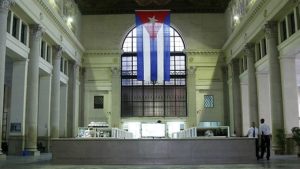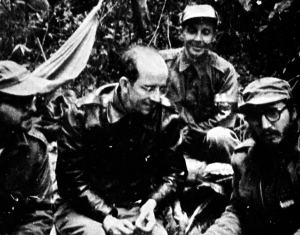Felipe Pazos a distinguish Cuban Economist was born in Habana on September 27, 1912, initially he supported the Cuban Revolution of Fidel Castro, but became disillusioned with the increasingly radical nature of the revolutionary government.
Born in Havana, Pazos earned a doctorate from the University of Havana in 1938. He was a member of the Cuban delegation to the 1944 Bretton Woods conference. In 1946, he joined the staff of the fledgling International Monetary Fund that had been established at the Bretton Woods conference. He worked there for three years before returning to Cuba in 1950 to head the newly established National Bank of Cuba for two years at the behest of Cuban President Carlos Prío Socarrás.
After Fulgencio Batista took power in Cuba through a military coup d’état in 1952, Pazos became active in supporting the resistance against Batista. Batista’s rule came under increasing assault during the 1950s, and he and the Cuban military soon found themselves fighting against a young Castro and the forces of his 26th of July Movement. At the time, Castro was waging a guerrilla campaign in the mountainous Sierra Maestra region of Cuba.
Batista had declared that Castro had been killed; however, Pazos arranged for New York Times reporter Herbert Matthews to come and meet Castro in February 1957. The resulting interview refuted Batista’s claims, and gave Castro and his revolutionaries international attention. In July 1957, Castro convened a meeting in the Sierra Maestra between his group of rebels and pro-Capitalist representatives, including Pazos. Pazos’ signature on the July 12 Sierra Manifesto was meant to help reassure the Cuban people that the revolutionaries were not radical ideologues. Pazos and his family were forced to flee Cuba soon after its release.
After Castro’s victory in 1959, Pazos returned to Cuba and once again headed the National Bank of Cuba. However, he soon found himself becoming increasingly disillusioned with the new Cuban government. In April 1959, Castro and his aides, including Pazos, visited the United States. Many had suspected that the purpose of the visit was to ask for economic aid, but Castro forbade Pazos from making any such requests. Pazos privately expressed his frustrations to officials at the U.S. State Department and Treasury Department.
Pazos’ confidence was further weakened when Castro ordered the arrest and imprisonment in October 1959 of Huber Matos, an anti-Communist revolutionary who had recently resigned from office. After Castro angrily denounced the United States for being complicit in the “bombing” of Havana with thousands of anti-Castro leaflets by the ex-Air Force Chief Pedro Luis Diaz Lanz, Pazos decided to resign. He tendered his resignation on October 23, 1959 to President Osvaldo Dorticós Torrado. Pazos was allowed to leave Cuba and left the country soon afterward.
Pazos ended up working at the Alliance for Progress and the Inter-American Development Bank, writing many economic articles on Latin America, before retiring in 1975 to Venezuela. He died in Puerto Ordaz on February 26, 2001.
He had three sons and a daughter. His son Felipe starred alongside Spencer Tracy in the 1958 film adaptation of Ernest Hemingway’s The Old Man and the Sea.
FELIPE PAZOS, FUNDADOR DEL BANCO NACIONAL DE CUBA, ECONOMISTA. (Nacido: Habana).
Felipe Pazos, un distinguido economista cubano, nació en La Habana, Cuba el 27 de septiembre de 1912, inicialmente apoyó la revolución cubana de Fidel Castro, pero se desilusionó con la naturaleza cada vez más radical del gobierno revolucionario.
Nacido en La Habana, Pazos obtuvo un doctorado en la Universidad de La Habana en 1938. Fue miembro de la delegación cubana en la conferencia de 1944 de Bretton Woods. En 1946, se unió al personal del incipiente Fondo Monetario Internacional que se había establecido en la conferencia de Bretton Woods. Trabajó allí durante tres años antes de regresar a Cuba en 1950 para dirigir el recientemente establecido Banco Nacional de Cuba durante dos años a instancias del presidente cubano Carlos Prío Socarrás.
Después de que Fulgencio Batista tomara el poder en Cuba a través de un golpe de estado militar en 1952, Pazos se hizo activo en el apoyo a la resistencia contra Batista. El gobierno de Batista fue objeto de un creciente asalto durante la década de 1950, y él y el ejército cubano pronto se encontraron luchando contra un joven Castro y las fuerzas de su Movimiento 26 de Julio. En ese momento, Castro estaba librando una campaña guerrillera en la montañosa región de Sierra Maestra en Cuba.
Batista había declarado que Castro había sido asesinado; sin embargo, Pazos hizo los arreglos para que el periodista del New York Times, Herbert Matthews, se reuniera con Castro en febrero de 1957. La entrevista resultante refutó las afirmaciones de Batista y brindó a Castro y sus revolucionarios atención internacional. En julio de 1957, Castro convocó una reunión en la Sierra Maestra entre su grupo de rebeldes y representantes procapitalistas, incluido Pazos. La firma de Pazos en el Manifiesto Sierra del 12 de julio estaba destinada a ayudar a tranquilizar al pueblo cubano de que los revolucionarios no eran ideólogos radicales. Pazos y su familia se vieron obligados a huir de Cuba poco después de su liberación.
Después de la victoria de Castro en 1959, Pazos regresó a Cuba y una vez más encabezó el Banco Nacional de Cuba. Sin embargo, pronto se encontró cada vez más desilusionado con el nuevo gobierno cubano. En abril de 1959, Castro y sus ayudantes, incluido Pazos, visitaron los Estados Unidos. Muchos habían sospechado que el propósito de la visita era pedir ayuda económica, pero Castro prohibió a Pazos hacer tales pedidos. Pazos expresó en privado sus frustraciones a los funcionarios del Departamento de Estado de los EE. UU. Y del Departamento del Tesoro.
La confianza de Pazos se debilitó aún más cuando Castro ordenó el arresto y encarcelamiento en octubre de 1959 de Huber Matos, un revolucionario anticomunista que había renunciado recientemente a su cargo. Después de que Castro denunciara enojado a Estados Unidos por ser cómplice en el “bombardeo” de La Habana con miles de panfletos anticastristas del ex jefe de la Fuerza Aérea Pedro Luis Díaz Lanz, Pazos decidió renunciar. Presentó su renuncia el 23 de octubre de 1959 al presidente Osvaldo Dorticós Torrado. Pazos pudo abandonar Cuba y abandonó el país poco después.
Pazos terminó trabajando en la Alianza para el Progreso y el Banco Interamericano de Desarrollo, escribiendo muchos artículos económicos sobre América Latina, antes de retirarse en 1975 a Venezuela. Murió en Puerto Ordaz el 26 de febrero de 2001.
Dejo a tres hijos y una hija. Su hijo Felipe protagonizó junto a Spencer Tracy en la adaptación cinematográfica de 1958 de El viejo hombre y el mar de Ernest Hemingway.
Agencies/Various/Wiki/Internet Photos/ Arnodo Varona/ thecubanhistory.com
THE CUBAN HISTORY, HOLLYWOOD.



 > FELIPE PAZOS, Cuban National Bank Founder, Economist. (Born: Havana). <> FELIPE PAZOS, Fundador del Banco Nacional de Cuba, Economista. (Nacido en La Habana).
> FELIPE PAZOS, Cuban National Bank Founder, Economist. (Born: Havana). <> FELIPE PAZOS, Fundador del Banco Nacional de Cuba, Economista. (Nacido en La Habana).







